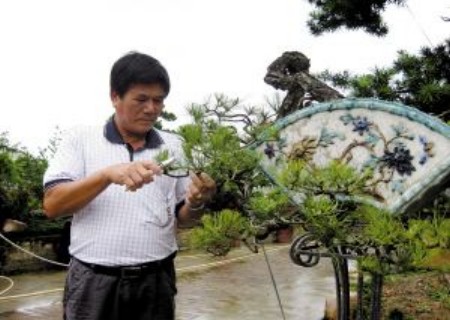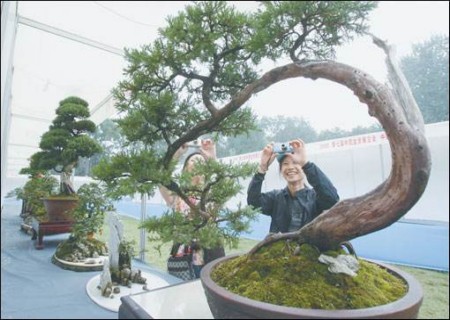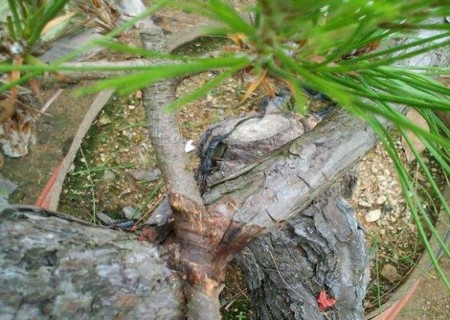Pruning and needle control method for bonsai of Pinus elliottii
Mountain pine, also known as Pinus massoniana, is a common tree species in Lingnan, and it is also one of the famous species for making bonsai. Its vigorous, rugged and simple body, vigorous and straight, green and evergreen, is gradually valued and loved by bonsai lovers. Famous artists of all ages often have masterpieces and are very popular with bonsai lovers.
But its needles are too long, the natural growth can reach about 25cm, not strong enough, when the strong wind blows for a long time, it appears dishevelled, soft and sagging, seriously affecting the shape and ornamental effect, so controlling the length of pine needles is an objective problem. In the past, some people controlled water and fertilizer to shorten the pine needle, but it was not ideal. How to shorten the needles (control needles) has become an important part of making Masson pine bonsai.

The normal growth of Pinus elliottii in Lingnan is to sprout new buds twice every year in March and August (different regions or due to growth and climate change will be different). After being preserved and forced to sprout, the tree skeleton has been stereotyped and the branches are denser, and the pile scene has initially entered the mature stage, the needle control can be carried out to improve the ornamental effect.
The method of needle control is to cut all the branches and claws synchronously according to the requirements of the crown shape, and the best time is when the new buds begin to sprout, when the sap flows and the explosive force is strong, which is beneficial to stimulate the cluster sprouts. Branches should be cut with at least four or more needles to prevent needles from losing branches, and for individual shoots that should not be shortened, the tip buds should also be removed in order to germinate synchronously.
Do not need shade after cutting, after about 20 days, each cut must sprout a number of new buds, forming clusters, such as trees are exuberant, a cut sprouting can reach more than ten, after cutting, strictly control water and fertilizer, when the new buds put needles grow to about 2cm, pick (cut) all the old needles at one time, and the ornamental effect will be shown initially. After three months, the needles grow to 4cm-5cm. At this time, the growing period is basically in place, and the needles are no longer growing. The delicate green needles contrast strongly with the rugged trunks, showing the unique characteristics of Masson pine seedling information bonsai. If you master it well, you can watch it continuously for more than four months.
In the process of needle control, attention must be paid to tree potential storage and cultivation. In the initial stage of bonsai modeling of mountain pine, no matter what modeling method is adopted, attention must be paid to the storage of branch support and forced bud modeling. As long as the growth is normal and the soil is loose, it can be applied thinly and frequently, and the steamed cake fertilizer or shell fertilizer and fish fertilizer can be mixed with more than 20 times of water. during the growth period, it can be released in an appropriate amount every month to let it grow madly, in order to preserve the tree potential, make the branch cortex loose, thicken and speed up. It is beneficial to bind or force the bud to form multi-stage branches and shorten the forming time. When the branches are stereotyped, the branches and claws are plump and the trees are exuberant, needle control can be carried out.
In the process of needle control, we should pay attention to several problems:
1. Tree potential conservation
In the initial stage of modeling, no matter what modeling method is used, we must first pay attention to the storage and cultivation (branch support), forced bud modeling, until the branches are stereotyped, the branches and claws are plump, and the tree is exuberant, we can control the needle.
2. Master the time
Cut back in the first three months of the viewing period. For example, the "May Day" viewing needs to be cut in early February and the "National Day" viewing in early July. Shearing after late autumn should be kept for a full three-month growth period according to the regional climate. If there is no special need, the needle control time is best when the bud is just sprouting.
3. Synchronous shearing
For each shearing, a certain number of needles should be retained on the whole to avoid excessive physiological imbalance of roots and leaves. The cutting mouth should be chosen in the dense place of the needle as far as possible, and it is best to cut it in the secondary germinating growth Internode; for the new branch that has not been lignified, the new bud will grow only after cutting, so it is difficult to control the needle.
4. Timely sprout thinning
After cutting, most of the needles are cut off, and the physiological balance between the branches, leaves and roots of the plant is greatly affected. In addition to strict water control, part of the roots can be cut off. The needles retained after shearing will adapt to the physiological needs of the root system through photosynthesis and transport nutrients to promote new buds. After the new buds germinated, the original needles could still enhance photosynthesis. At this time, the bud heads are clustered, but they are extremely crisp, so it is necessary to prevent impatient, premature and random wiping of buds and picking leaves.
5. Remove the old leaves
When the new buds grow around 2cm, some over-dense or underdeveloped bud heads can be erased step by step to make the new buds grow symmetrically. Cut off all the old needles (take away the new buds from the axils of the easy leaves by hand at the same time) to control the new buds from growing too fast.
6. Control water and fertilizer
Too wet basin soil can easily cause rotten roots, while excessive fertilizer will lead to nutrient reflux or burn roots, often resulting in premature death, so fertilizer and water control must be prohibited at the initial stage of needle control, and be sure to make the basin soil dry. After the germination of new buds, normal watering can only be restored step by step, and fertilization is not allowed. If the needles are too weak or yellowing, ferrous sulfate and fish fertilizer or other foliar fertilizer can be sprayed appropriately, but alkaline fertilizer and nitrogen fertilizer should not be applied.
7. The combination of needle control and stocking
After the whole plant shrunk to control the needle, it is bound to destroy its physiological balance, plant self-regulation will abandon part of the roots, and even part of the root system, so that the growth of the growing period will be slow; if the old leaves are removed, the growth will be obviously weakened, so it is necessary to give full opportunities to recuperate and take care of them. After the growing period, when the new buds have been lignified or not lignified, the buds can be fully thinned and released, according to the modeling needs, combined with branches and claws, only two bud heads (new branches) are left in each cut, and the rest are cut off.
Time: 2019-06-09 Click:
- Prev

Bending modeling skills of mountain pine bonsai
Mountain pine trees, tall, thin, straight, upright, mountains everywhere, can be seen everywhere, for the construction of wood. No one knows about its fine nature. Therefore, bonsai lovers break the conventional modeling, looking for strange, special, strange negative materials, in order to innovate. In principle, the modeling of mountain pine bonsai takes showing vigor and elegance as the theme.
- Next

Grafting method of mountain pine potted landscape
Grafting can improve the quality and improve the ornamental effect, so grafting is often used in bonsai creation. Due to the strong germination of green wood, the first cut down the mountain is often to cut off the high trunk, use the ideal lateral branches of the pile foundation to cultivate the new trunk, dwarf, and concentrate it into the scene in the pot. but
Related
- Fuxing push coffee new agricultural production and marketing class: lack of small-scale processing plants
- Jujube rice field leisure farm deep ploughing Yilan for five years to create a space for organic food and play
- Nongyu Farm-A trial of organic papaya for brave women with advanced technology
- Four points for attention in the prevention and control of diseases and insect pests of edible fungi
- How to add nutrient solution to Edible Fungi
- Is there any good way to control edible fungus mites?
- Open Inoculation Technology of Edible Fungi
- Is there any clever way to use fertilizer for edible fungus in winter?
- What agents are used to kill the pathogens of edible fungi in the mushroom shed?
- Rapid drying of Edible Fungi

